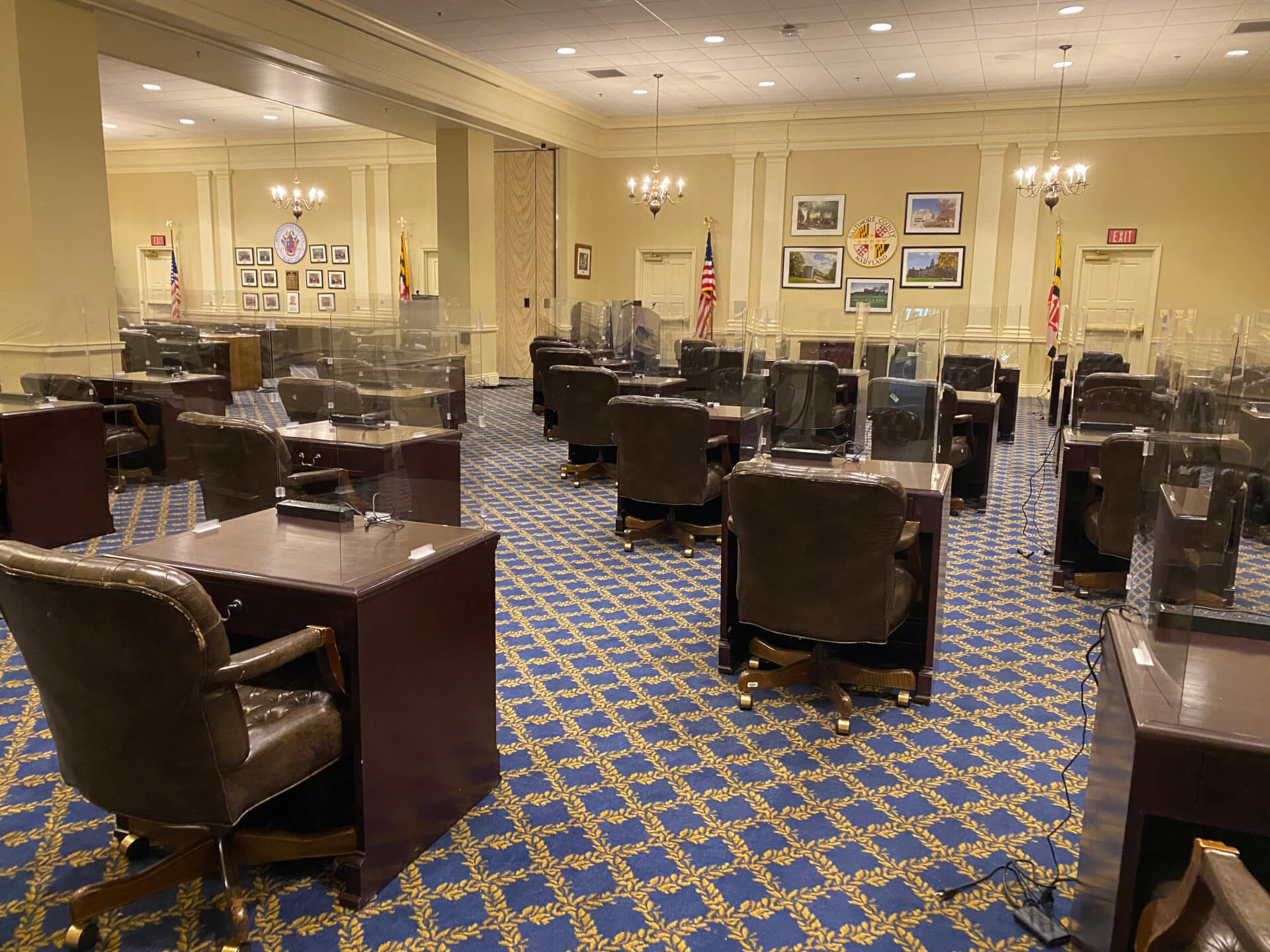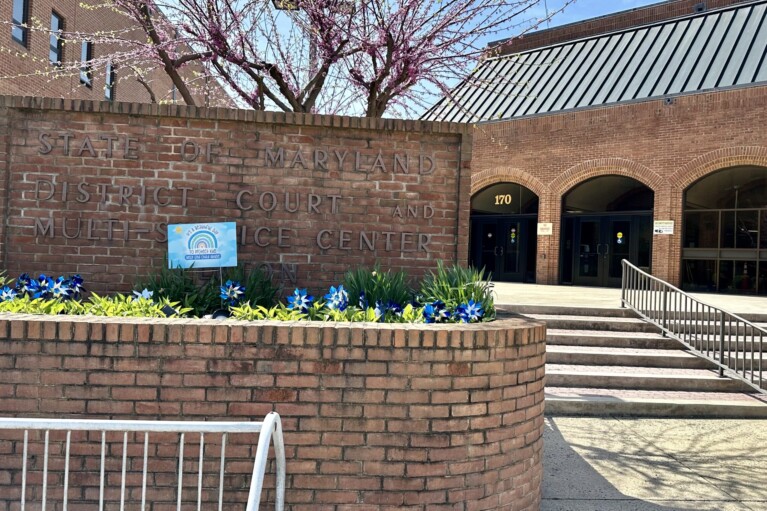Here’s How Other State Legislatures Are Returning to Work

Editor’s note: Earlier this month, the presiding officers of the Maryland General Assembly outlined tentative plans for reconvening in January while keeping lawmakers and the general public safe during a spike in COVID-19 cases. Committees will hold virtual hearings throughout the session, pedestrian traffic will be severely limited in the State House and legislative buildings, and lawmakers will have plexiglass shields surrounding their desks on the House and Senate floor — and half the House members will meet in a Chamber Annex, a makeshift House floor that is being set up in two large meeting rooms in the Lowe House Office Building.
Similar plans are being made in state legislatures throughout the country. Here is a survey of what some of them are doing.
By Jenni Bergal
Lawmaking during a pandemic is a challenge.
The coronavirus is raging out of control in many parts of the country, and most state legislatures will reconvene in a few short months. To do it safely, they are weighing a variety of potential changes, from sometimes contentious mask requirements to plexiglass partitions to mandatory health screenings for anybody entering the statehouse.
One state even considered — and dismissed — creating an NBA-style “bubble” for lawmakers.
Much is at stake. At least 162 state legislators nationwide have tested positive for the virus, according to numbers compiled by The Associated Press, and three have died.
Many legislatures still are in the planning stages, considering options about whether to meet in person, move to a different location, go virtual — as many did after the pandemic struck — or opt for a hybrid plan.
“Nobody should have to choose between doing their job to help their communities and risking their health and safety,” said Vermont House Speaker Mitzi Johnson, a Democrat.
Decisions for 2021 are complicated, said Angela Andrews, who directs the legislative staff services program at the National Conference of State Legislatures.
“Do they limit access to the building?” she asked. “Should there be temperature cameras? What does social distancing look like in a committee room and who can be allowed in? Do you do rapid COVID tests on the legislators, the staff or others?”
In South Dakota, work is underway to wire the chambers and upgrade and renovate legislators’ meeting rooms in the Capitol to make it easier for remote access. Officials expect the $350,000 project to be reimbursed with federal CARES Act funds.
“Right now, there are many members who think we should just go back and do things as normal. I do not fall in line with that camp,” said South Dakota Senate Minority Leader Troy Heinert, a Democrat and member of a subcommittee working on a plan for the 2021 session.
Heinert said he supports a hybrid model in which members and the public can participate remotely if they choose.
“I’m nervous about COVID all the time,” he said. “My wife has some underlying health conditions. We’re very cautious.”
Heinert, who is a member of the Rosebud Sioux Tribe and lives on the reservation, said his community has curfews, lockdowns and mask mandates.
Masks are a hotly debated topic among legislators, Heinert said.
“We lost a member of the House to COVID,” he said, referring to Republican state Rep. Bob Glanzer, who died in April. “I just don’t understand why we wouldn’t do everything possible to keep everybody as safe as possible when we know that this virus has a propensity to take someone’s life.”
In Utah, legislative leaders briefly discussed creating a long-term residential bubble for lawmakers similar to the NBA’s system of having its players live in a sports and hotel complex with no outside interactions for months, but ruled that out, said state Senate President Stuart Adams, a Republican.
Legislators didn’t want to leave their homes and families for an entire, seven-week session, nor did they want to restrict interaction with the public.
“There are interpersonal relationships going on as we’re crafting legislation and with constituents,” Adams said. “If we limit those relationships, our policies aren’t as well refined and aren’t as good.”
Instead, legislative leaders are discussing a plan for the state health department to administer daily, rapid COVID-19 testing for lawmakers and staffers when the session starts in January. They’re also considering plexiglass dividers between legislators’ desks. Four large committee rooms at the state Capitol complex have been modified to allow for social distancing for legislators and the public during hearings.
“Utah would very much like to have the traditional in-person session. That would be our goal,” Adams said. “But the most likely model will probably be blended.”
That means some people would be allowed to come and testify and others could do so virtually, he said.
But if conditions worsen, the legislature could move to all virtual hearings, as it did during some of its special sessions in the spring, he said.
One worry is the tight chambers for the 29 senators and 75 representatives, which Adams called “a fishbowl where COVID could spread fairly rapidly.” But they haven’t agreed yet on whether to require masks on the floor.
Utah legislators and staff will be able to work virtually if they choose, said Adams, who tested positive for COVID-19 antibodies and knows of at least four colleagues who have gotten the virus.
Virtual or not?
In Wyoming, the legislative Management Council’s tentative plan calls for an in-person session. Plexiglass shields would be installed at the front desks and chamber podiums. While the public could participate at committee meetings remotely, limited numbers also could attend in person.
All members and staffers would be tested before the start of the session, under the proposal. It would require staffers to wear masks and “strongly recommend” them for members and the public.
Legislative staff decided against an all-virtual general session, as the lawmakers had done during an earlier special session.
“It’s just not something you could really feasibly do — a long session over a virtual platform such as Zoom — [that would allow] the level of public participation and collaboration and compromise between members,” Legislative Service Office Director Matt Obrecht said at an October meeting.
In Indiana, a joint committee created by the Legislative Council has submitted a plan that recommends the House hold its session in the adjoining Government Center’s large conference room, which is like a ballroom. The smaller Senate would stay in its chamber but retrofit the public gallery into seating for senators to allow social distancing and space to vote.
House members would have their own table wired to voting machines, said Indiana state Rep. Matt Lehman, who co-chairs the committee.
“We set that up as our Plan B,” the Republican said. “The closer we get to January, it looks like that is going to be our temporary chamber until we can return.”
The committee’s plan received bipartisan support, Lehman said.
“It’s not along party lines. A few have disagreed and said it’s too aggressive or not aggressive enough,” he said. “But overall, the recommendations have been unanimously supported by both parties.”
The committee still is discussing whether to require masks, a controversial topic in a state where Republican Gov. Eric Holcomb has issued a mask mandate. It’s also talking about whether to allow members to vote from their offices or the Indiana State Capitol but has agreed for the most part not to allow voting from home.
“Our plan is that you must be present to participate,” Lehman said, “but we want those at high risk to feel safe.”
Change of plans
After the virus hit in March, at least 26 legislatures had to suspend, postpone or temporarily adjourn their sessions, according to Natalie Wood, who directs NCSL’s Center for Legislative Strengthening.
Some chambers wound up meeting in alternative venues.
In Illinois, the House approved its budget in a concert arena in Springfield. In New Hampshire, the 400-member House wrapped up its session in a hockey arena.
Since the pandemic, at least 25 legislatures, either one chamber or both, adopted rules or legislation to allow for remote participation, according to Wood. In most, they used virtual meeting tools such as Zoom and live-streamed proceedings to allow public participation.
In Vermont, both the House and Senate went virtual, adopting emergency rules allowing members to vote and debate remotely. They conducted business using Zoom and streamed it on YouTube for the public.
A recent study by a consultant the legislature hired determined that, under guidelines issued by the federal Centers for Disease Control and Prevention, the House chamber can safely hold only 70 people. There are 150 members, plus staff, media, advocates and the public, Speaker Johnson noted.
She wants to use large empty meeting rooms in adjacent office buildings for committees as well as for remote floor participation. Masks would be required. Members or staffers also could work virtually if they choose.
Johnson lost her seat in a close race last week and has asked for a recount. If the results stand, Democrats, who hold a majority in the chamber, will have to elect a new House speaker.
Election charges
Likewise, decisions in some other states also will hinge on the results of the recent election or leadership changes.
In Texas, for example, Republican House Speaker Dennis Bonnen is retiring, and until legislators choose a presumptive speaker in January, plans for the 2021 session are still up in the air.
In August, however, a majority of state representatives who filled out a survey supported requiring face masks, routine testing for members and staffers, and daily temperature checks at the Texas Capitol.
One of the biggest unknowns for the upcoming session is how legislators will be affected if they or their colleagues get infected.
Last month, the Pennsylvania House canceled a voting session after one of its members tested positive.
In Mississippi, the state health officer said at least 49 state legislators tested positive for COVID-19 during the session that recessed in early July.
And lawmakers continue to be diagnosed with the coronavirus.
In Arkansas, the legislature halted budget hearings for a week in mid-October after several members tested positive. So far, at least 10 have gotten the virus.
Heinert, the Democratic minority leader in South Dakota, said legislators have a responsibility to protect not only their colleagues but also their communities when they meet next year.
“The last thing we should be doing,” he said, “is bringing this virus from the Capitol to other parts of the state.”




 Creative Commons Attribution
Creative Commons Attribution